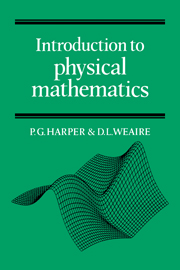Book contents
- Frontmatter
- Contents
- Preface
- Some notes on notation
- 1 Introduction
- 2 Errors
- 3 Cartesian coordinates
- 4 Vectors
- 5 The scalar product
- 6 The vector product and rotation
- 7 Matrices in physics
- 8 The transformation of matrices
- 9 The matrix eigenvalue equation
- 10 Exponential and logarithm functions
- 11 Sine and cosine functions
- 12 Graph plotting and curve sketching
- 13 Differentiation
- 14 Approximations
- 15 Power series and Taylor's expansion
- 16 Partial differentiation
- 17 Integration
- 18 The differential equation
- 19 Solving first-order differential equations
- 20 Second-order differential equations
- 21 Solving second-order differential equations
- 22 The complex exponential
- 23 The circuit equation
- 24 Harmonics and Fourier series
- 25 The diffusion equation
- 26 Waves
- 27 The rate of change of a vector
- 28 The scalar field and gradient operator
- 29 The vector field
- 30 Line integration
- 31 The potential field
- 32 Surface and volume integration
- 33 Flux and divergence
- 34 Circulation and the curl
- 35 Conclusion
- 36 Miscellaneous exercises
- Index
10 - Exponential and logarithm functions
Published online by Cambridge University Press: 20 October 2009
- Frontmatter
- Contents
- Preface
- Some notes on notation
- 1 Introduction
- 2 Errors
- 3 Cartesian coordinates
- 4 Vectors
- 5 The scalar product
- 6 The vector product and rotation
- 7 Matrices in physics
- 8 The transformation of matrices
- 9 The matrix eigenvalue equation
- 10 Exponential and logarithm functions
- 11 Sine and cosine functions
- 12 Graph plotting and curve sketching
- 13 Differentiation
- 14 Approximations
- 15 Power series and Taylor's expansion
- 16 Partial differentiation
- 17 Integration
- 18 The differential equation
- 19 Solving first-order differential equations
- 20 Second-order differential equations
- 21 Solving second-order differential equations
- 22 The complex exponential
- 23 The circuit equation
- 24 Harmonics and Fourier series
- 25 The diffusion equation
- 26 Waves
- 27 The rate of change of a vector
- 28 The scalar field and gradient operator
- 29 The vector field
- 30 Line integration
- 31 The potential field
- 32 Surface and volume integration
- 33 Flux and divergence
- 34 Circulation and the curl
- 35 Conclusion
- 36 Miscellaneous exercises
- Index
Summary
In seeking to express efficiently the dependence of one variable upon another, physicists have developed a repertoire of familiar functions which have well-defined properties and can be used in combination with each other to describe more complicated ones. They are the basic building blocks of practical mathematical analysis. In these two chapters we shall discuss the most elementary ones – the exponential, logarithmic and trigonometric (or circular) functions. Later, we shall see that further ‘special functions’ can be useful and that there is no end to this process. The skilled applied mathematician, like the skilled linguist, acquires a wide and powerful vocabulary. Usually, when we speak of an ‘exact’ solution to a physical problem we mean that a solution can be expressed in terms of familiar functions. Thus the availability of such a solution depends upon the range of one's vocabulary of functions.
Probably the most widely discussed, if not always identified, function in or out of physics is the exponential. Radioactive decay – ‘the half-life of 42K is 12.4 hours’, i.e. at the end 12.4 hours the initial activity has reduced to one-half. Exponential growth – ‘invest your surplus cash in X holdings at 20% (taxable)’. Sometimes threatening – ‘if unchecked, the world demand for energy will double every ten years’. Let us look more closely at the everyday example of bank interest.
- Type
- Chapter
- Information
- Introduction to Physical Mathematics , pp. 62 - 68Publisher: Cambridge University PressPrint publication year: 1985



